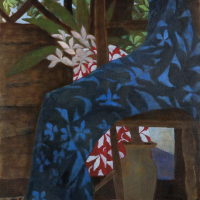224. RAY CROOKE

Theres the stillness, that moment caughtI like the painting to be well constructed, to contain the eye, and also to have passage which one can move across. In other words, I think my impetus is to paint the one perfect painting which, under the paint, contains all those things. I like things static. My figures are waiting.1
The stillness, described here by Ray Crooke, is the essence of his art; from his early Victorian landscapes to the island and coastal scenes, his painting contained an innate sense of calm tranquility which were inspired by the artists early visits to the Western Australian coast, Northern Queensland and Borneo. Throughout his career, Crookes artistic objective was to simply paint his own experiences - unlike many of his contemporaries whose styles were cultivated by the trends coming out of European and American creative circles.
Growing up in rural Victoria with an artistic father, Crooke was exposed to drawing from a young age and would spend hours in the State Library of Victoria flipping through books on the Pacific, daydreaming of one day visiting the idyllic Eden himself. It was not long before the war took him to the Cape York Peninsula and Borneo, an experience he found confronting however one which made an indelible impression on the artist. Breaking away from the comforts of home, Crooke not only matured as a person but gained an invaluable education on an artistic level and a fundamental understanding of the post-war world.
Following the war, Crooke spent time painting in isolation, refining his practice and exploring themes and techniques which he felt comfortable with and which reflected himself as an artist. Crooked admired the work of Arthur Boyd (1920-1999), Sidney Nolan (1917-1992) and Russell Drysdale (1912-1981) who were already well-established in Australia and overseas, he was also interested in the work of the Sydney Charm School painters however was too young to have a connection with these artists. He found inspiration in his own wartime drawings and studies of the small towns and villages he had visited; it was his own material and memories which would provide enduring inspiration to the artist.
The present work, Island Interior, is an exceptional example of Crookes idyllic, timeless compositions; where light and shade evoke a unique sense of stillness. Here, Crooke has offset the cool shade of the interior with the warmth of the red patterned fabric. The suggestion of a figure is visible through the layers, drawing the viewers gaze through the composition. The palette employed here is characteristic of Crookes most evocative works and demonstrates the artists highly developed sense of colour.
His vision reaches beyond the immediate subject to reveal things of enduring validity in the relationship between man and naturehe belongs to that rare group of artists who have subtly changed our way of looking at the world. He has revealed the tropical north as it has never been revealed beforewe now tend to see that part of the country through his eyes and with his vision.2
Footnotes
- Ray Crooke cited in Walker, R., Painters in the Australian Landscape, Hale and Iremonger, Sydney, 1988, p.37
- Gleeson J., North of Capricorn: the art of Ray Crooke (exhibition catalogue), Perc Tucker Regional Gallery, Queensland, 1997, p.20
Caroline Jones BA, MArtAdmin